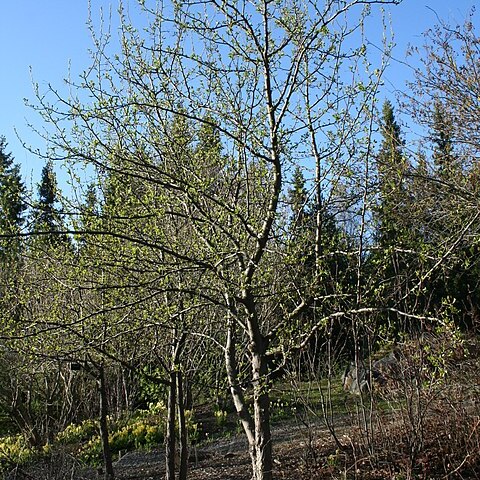Shrubs to 2 m tall. Branches grayish green to purplish brown, robust, glabrous; branchlets reddish brown, longitudinally angled, glabrous; spines erect to recurved, 6–10 mm, usually leafless. Winter buds purplish red, ovoid, pubescent. Petiole 5–10 mm, glabrous; leaf blade ovate-lanceolate, lanceolate, or very rarely lorate, 3–6.5 × 0.6–2 cm, abaxially pale green, adaxially dark green, base subrounded to broadly cuneate, margin remotely serrate, apex acute, acuminate, or caudate; secondary veins abaxially prominent, adaxially impressed. Inflorescences in leaf axils, 1-flowered or to a 4-flowered fascicle; bracts small, membranous, lanceolate, adaxially pubescent, glabrescent. Flowers ca. 1.5 cm in diam. Pedicel 1–1.8 cm, to 2 cm in fruit, glabrous. Hypanthium campanulate, outside glabrous. Sepals triangular-ovate, short, outside glabrous, margin ciliate. Petals yellow, obovate, base shortly clawed, apex obtuse. Stamens ca. 10, in 2 whorls. Ovary glabrous. Style short. Drupe purplish red to purplish brown, subglobose to oblong, 1–1.5 cm in diam., glabrous. Fl. Apr–May, fr. May–Sep.
More
A spreading open shrub. It has spines and loses its leaves during the year. It grows 2-3 m tall. The crown is rounded. The leaves are sword shaped and bright green. They are 8 cm long and 2.5 cm wide. The flowers are bright yellow and have 5 petals. They are fragrant. The flowers are produced along the entire stem length. They are in clusters of 1-4 on the previous year's growth. They fruit is cherry like. It is edible.
In the shade of mixed forests and in shrubberies, especially on pebbly or alluvial soils. Mixed forests, forests of shady slopes, open places on slopes and beside streams in northern China.
More
It is a temperate plant. It grows in shady places and open places and beside streams. It suits hardiness zones 5-9.

